Question
Deer mice, Peromyscus maniculatus, are small rodents that live in North America. Like all mammals, their blood contains haemoglobin which combines with oxygen in the lungs, and unloads its oxygen in respiring tissues.
Deer mice show variation in their genotypes for the genes that code for the α-polypeptide chain of haemoglobin. In most populations of deer mice, the majority of individuals have the genotype A1A1, while a smaller number have the genotype A0A0.
(a) In mice with the genotype A1A1, the amino acid at position 64 in the α-polypeptide chain is aspartic acid. In mice with the genotype A0A0, the amino acid at this position is glycine.
Suggest how the change from aspartic acid to glycine in the α-polypeptide chain could have been brought about.[2]
(b) The genotypes of deer mice from three different populations, each living at a different altitude, were analysed. Fig. 5.1 shows the relative proportions of deer mice with aspartic acid (white areas) and glycine (black areas) at position 64 in the α-polypeptide of
their haemoglobin.
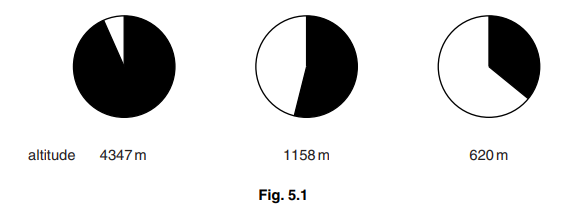
(i) Describe the effect of altitude on the frequency of the haemoglobin alleles in these populations of deer mice.[2]
(ii) The partial pressure of oxygen is relatively low at high altitudes. Haemoglobin containing glycine at position 64 in the α-polypeptide chain has a higher affinity for oxygen than haemoglobin with aspartic acid at this position.
Suggest how natural selection could account for the difference in allele frequency in deer mice living at high altitudes and low altitudes.[4] [Total: 8]
Answer/Explanation
Ans:
5 (a) random/ spontaneous ;
mutation ;
base/nucleotide/triplet, change/ substitution ; R addition/ deletion
(b) (i) as altitude increases frequency of A0 increases ; ora for A1
A0 more frequent at high altitudes / A1 more frequent at low altitudes / intermediate frequency of either allele at intermediate altitude ;
(ii) idea of (pre-existing) genetic variation in deer mouse population ;
at high altitude mice with, glycine/A0, more likely to survive/ have selective advantage ; ora
mice (with A0 ) reproduce (at high altitude) ; ora
and pass on the A0 allele ; ora
partial pressure/ concentration, of O2 acts as a selection pressure ;
ref. to disadvantage of haemoglobin with very high affinity at low altitude ;
as less able to unload oxygen (in respiring tissues) ;
Question
Spraying insecticide on the walls inside houses is the main method of controlling a species of Anopheles mosquito in rural India. A number of different insecticides have been used.
Malathion was the main insecticide used for many years. In 2005 the newer insecticide, deltamethrin, was used instead and the use of malathion was discontinued.
A laboratory study was carried out using mosquitoes collected from two sites in India. The percentage of mosquitoes killed by malathion and deltamethrin was estimated.
The results of the study are shown in Table 4.1
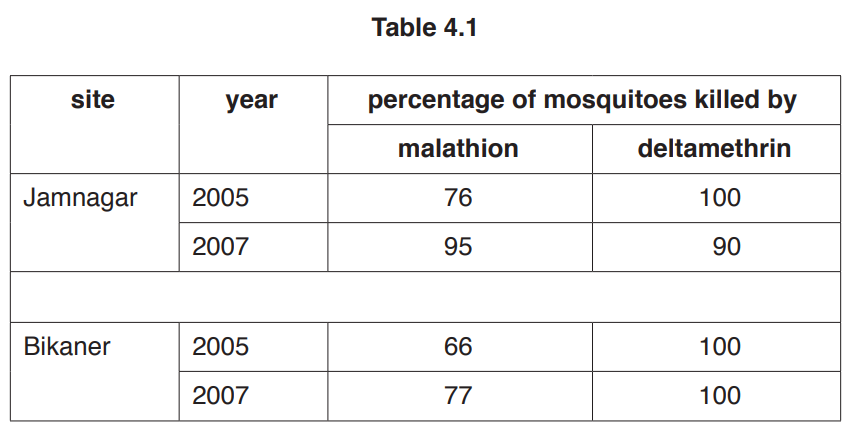
(a) With reference to Table 4.1, describe the difference in effectiveness of the two insecticides.[3]
(b) The researchers concluded that at Jamnagar, the mosquitoes had evolved resistance to deltamethrin.
Explain how the mosquitoes evolved resistance.[4]
(c) Explain how the data in Table 4.1 show evidence that the use of malathion was discontinued after 2005.[2]
(d) The resistance of mosquitoes to malathion was found to be due to a difference in the shape of one enzyme.
Name the type of variation controlling malathion resistance in the mosquito population.[1]
(e) Some students suggested that resistance to malathion could be due to a gene with two alleles. They proposed that the allele for resistance to malathion would be dominant to the allele for non-resistance.
Using this assumption, the data in Table 4.1 can be used to calculate the frequency of resistant mosquitoes and the frequency of the allele for resistance in a mosquito population.
Use the Hardy-Weinberg principle to calculate the frequency, p, of the allele for resistance in Jamnagar in 2005.[3] [Total: 13]
Answer/Explanation
Ans:
4(a) three from
1 (overall) deltamethrin, more effective / better, (at killing mosquitoes) ;
2 figures for malathion and deltamethrin with named site and year R Jamnagar in 2007 or mean 78.5% for malathion and 97.5% for deltamethrin ;
3 malathion, kills higher percentage (of mosquitoes)/is more effective, than deltamethrin in Jamnagar in 2007 ;
4 percentage of mosquitoes killed by deltamethrin decreasing in Jamnagar ;
5 percentage of mosquitoes killed by malathion increasing (in both locations) ;
4(b) four from
1 (random) mutation /genetic variation ; A description of mutation
2 deltamethrin acts as a selection pressure ;
3 resistant mosquitoes have selective advantage ; ora
4 resistant mosquitoes, survive /reproduce ; ora
5 resistance alleles passed on ;
6 increase in frequency of resistance allele ; ora
7 natural /directional, selection ;
4(c) two from
1 percentage of mosquitoes killed (by malathion) increases ;
2 (malathion) selection pressure removed /resistance to malathion is no longer a selective advantage ;
3 idea of resistance not needed ;
4(d) discontinuous ;
4(e) p=0.13 ; ; ;
allow max 2 for working
q2 / frequency of non-resistant (mosquitoes) = 0.76
q = 0.87
Question
(a) All modern breeds of dog belong to the same species and are thought to have originated from 14 ancient breeds by the process of artificial selection. The golden retriever is a modern breed that is often used as a guide dog for people who are blind or visually impaired.
Fig. 1.1 shows a golden retriever.
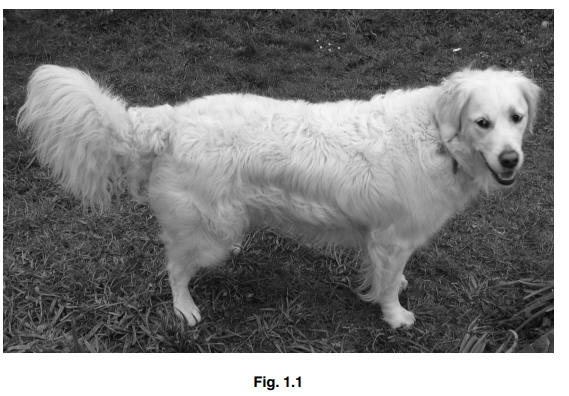
Explain how the principles of artificial selection would have been used to produce golden retrievers with the characteristics required for a guide dog.[4]
(b) The domestic dog, Canis familiaris, is found worldwide. It is able to breed with all other members of the genus to form fertile hybrids.
The distribution of some of the species belonging to the genus Canis is shown in Fig. 1.2.
The dingo and the grey wolf species have distinct ranges but the ranges of three species of jackal overlap in East Africa.
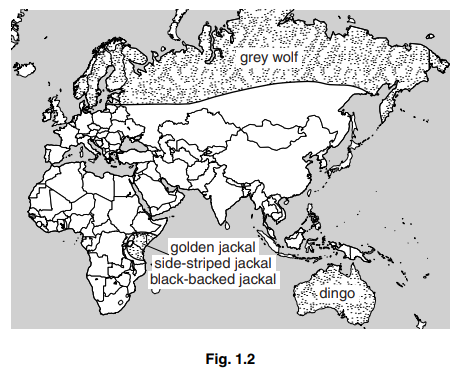
Table 1.1 shows whether members of different species of the genus Canis are able to breed with each other.
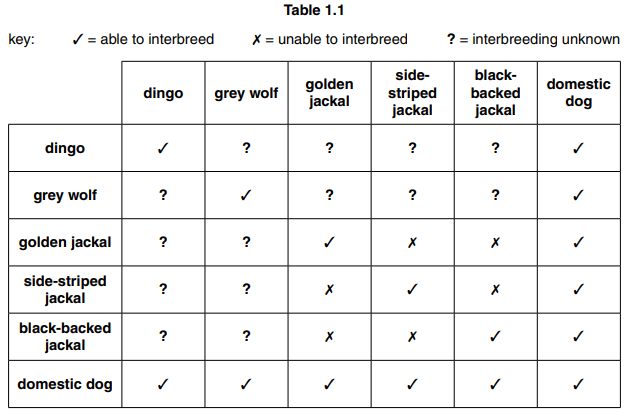
(i) Suggest the type of isolating mechanism preventing:[2]
- the three species of jackal interbreeding
- the dingo mating with all the other members of the genus Canis apart from the domestic dog.
(ii) Using the information in Fig. 1.2 and Table 1.1, state:[2]
- one reason why the members of the genus Canis could be described as one species
- one reason why they should be described as separate species.
[Total: 8]
Answer/Explanation
Ans:
1 (a) 1 (ideal characteristics) selected by humans/AW ;
2 one example of features ; e.g. calm temperament/obedient/intelligent
3 allowed to mate/bred together ;
4 offspring with ideal characteristics chosen to mate ;
5 over (many) generations ;
6 allele frequency (for ideal characteristics) increases ;
7 directional selection ;
(b) (i) jackal
behavioural/reproductive/AW ;
dingo
geographical/AW ;
(ii) one species
all breeds form fertile offspring with (domestic) dog ;
separate species
idea of different types of jackal do not interbreed (to produce fertile offspring) ;
